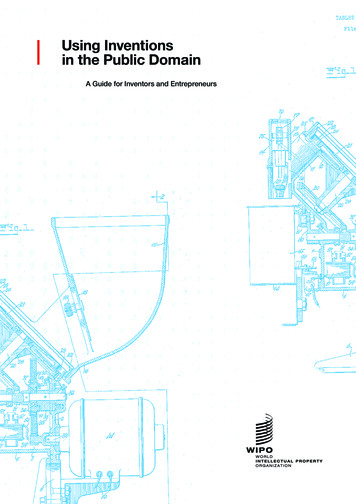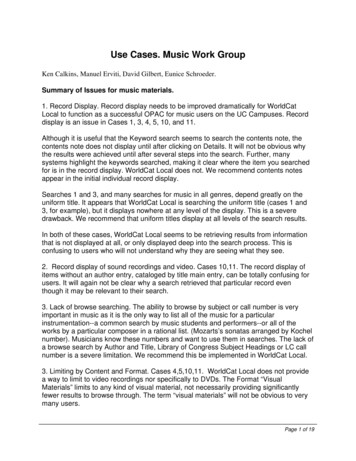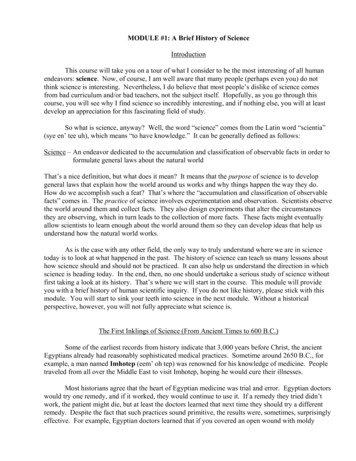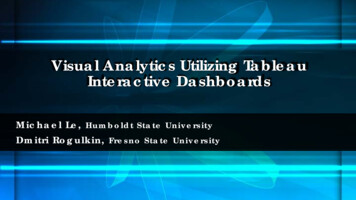
Transcription
Using Inventionsin the Public DomainA Guide for Inventors and Entrepreneurs
Using Inventionsin the Public DomainA Guide for Inventors and Entrepreneurs
Except where otherwise indicated, this publication is licensed under theCreative Commons Attribution 3.0 IGO License.The user is allowed to reproduce, distribute, adapt, translate and publiclyperform this publication, including for commercial purposes, without explicitpermission, provided that the content is accompanied by an acknowledgementthat WIPO is the source and that it is clearly indicated if changes were madeto the original content.Suggested citation: WIPO (2020), Using Inventions in the Public Domain:A Guide for Inventors and Entrepreneurs. Geneva: WIPO.Adaptation/translation/derivatives should not carry any official emblem or logo,unless they have been approved and validated by WIPO. Please contact usvia the WIPO website to obtain permission.For any derivative work, please include the following disclaimer: “The Secretariatof WIPO assumes no liability or responsibility with regard to the transformation or translation of the original content.”When content published by WIPO, such as images, graphics, trademarks orlogos, is attributed to a third party, the user of such content is solely responsible for clearing the rights with the right holder(s).To view a copy of this license, please visit https://creativecommons.org/licenses/by/3.0/igoThe designations employed and the presentation of material throughout thispublication do not imply the expression of any opinion whatsoever on thepart of WIPO concerning the legal status of any country, territory or area orof its authorities, or concerning the delimitation of its frontiers or boundaries.This publication is not intended to reflect the views of the Member States orthe WIPO Secretariat. The mention of specific companies or products of manufacturers does not imply that they are endorsed or recommended by WIPOin preference to others of a similar nature that are not mentioned.Porter’s generic value chain (p. 35), is taken from Competitive Advantage:Creating and Sustaining Superior Performance by Michael E. Porter. Copyright1985 Michael E. Porter. Reprinted with the permission of The Free Press, aDivision of Simon & Schuster, Inc. All rights reserved. WIPO, 2020First published 2020World Intellectual Property Organization34, chemin des Colombettes, P.O. Box 18CH-1211 Geneva 20, SwitzerlandISBN: 978-92-805-3040-7Attribution 3.0 IGO(CC BY 3.0 IGO)Photo credits: Wikimedia; olga hmelevska/iStock/Getty Images PlusPrinted in Switzerland
Table of contentsAcknowledgments 7Introduction to the guide 81. Framework for the guide 85. Unique selling proposition andits relevance in IP regimes 21272. Considerations for using the guide 103. Purpose of the guide 10Module IIIIntegrating public domainknowledge into productdevelopment processes 4. Scope of the guide 111. Idea phase 285. Limitations of the guide 121.1 Introduction 281.2 Idea and its significance 291.3 What is an invention black box? 291.4 Product idea scoring and screeningusing the balanced scorecard 312. Evaluating team culture andcapabilities 332.1 Against the flow 332.2 Should you abandon the effortor move on to design? Innovate and/or cooperate? 34Module IDefining the public domain andits relationship with patents 131. Understanding public domaininformation and knowledge as itrelates to new product development 141.1 Public domain as a function ofgeography and time 142. Relationship between patentsand the public domain 153. Public domain in developing andleast developed countries 152.3 Value chain analysis in anassessment of a firm’s competitiveenvironment 352.4 Evaluation of available resources(internal and external) 353. Developing a product concept 383.1 Is there a feasible product concept? 384. Market opportunities 382. Territorial scope of patent protection 194.1 Market data and research 403. Examples of useful information foundin patent publications 195. Reviewing what technologiesare already in the market 424. Other IP rights 20Module IIFinding opportunities toleverage inventions and publicdomain knowledge 1. Relationship between inventionsand patents 1718
6. Finding if there are availabletechnologies you can exploit toidentify market opportunities 13. Post-launch 694414. Conclusion 706.1 Patent intelligence based on patentdatabase searches, patent statisticsand reports 44Annex 716.2 Relevant patent identification 47Endnotes 737. Drafting a business model canvas 488. Screening product concepts 498.1 Introduction 498.2 Validating market pull 498.3 Using competitive intelligenceand technology intelligence 518.4 Assessing competitive advantagethrough competitive intelligence 518.5 Technology intelligence throughpatents to study evolving technologytrends and innovation 538.6 Assessing the ability to build ateam and obtain stakeholders’ support 538.7 Protecting IP in feasible products 558.8 Strengths, weaknesses,opportunities, threats (SWOT) analysis 579. Design 599.1 Introduction 599.2 Solution of a technical problemthrough TRIZ 599.3 Determining the 5Ps and usingthem as a guide for design 619.4 Design for manufacturing andtechnology risk management 6410. Development and implementation 6811. Test 6812. Launch 69
AcknowledgmentsThis publication is a result of a project commissioned by the World Intellectual Property Organization(WIPO) Development Agenda Project on the Use of Information in the Public Domain for EconomicDevelopment. The lead subject matter expert was James G. Conley, with editorial assistanceprovided by Komal Bajracharya, and the associate subject matter experts were Rodrigo TrujilloLamas and Vassilios Vlahakis. The publication also benefited from valuable inputs from PhyllisLeah Speser.7
USING INVENTIONS IN THE PUBLIC DOMAIN:A GUIDE FOR INVENTORS AND ENTREPRENEURSIntroduction to the guideThis guide is designed to help researchers, inventors, entrepreneurs and micro, small andmedium-sized enterprises gain access to, and use, information in the public domain, knowledgeand technology for invention, innovation and product development in their own country. To bein the public domain means that information, knowledge or technology is not proprietary andmay be freely accessed by anyone. The focus of this guide is on information and technologydisclosed in patent documents. By patent documents, we refer to published patents and patentapplications plus other publicly accessible official information about pending and issued patents,such as that available through patent offices or courts. The process by which inventions andinnovations become products and/or services is called new product development (NPD). NPDis a disciplined and defined process comprising a set of tasks, steps and decision gates that anorganization or individual uses to convert embryonic ideas into salable products and services.Terminology hintThe phrases public domain information and information in the public domain are used interchangeably in this guide. So too are the phrases public domain knowledge and knowledgein the public domain.1. Framework for the guideThis guide’s overall content is based on the use of information about inventions available in thepublic domain with emphasis on inventions disclosed in patent documents. The public domainis the domain of everything that is not owned by (proprietary to) a non-governmental party. Data,know-how, techniques, information, knowledge and land are all examples of things which maybe in the public domain. Information and knowledge concerning inventions disclosed inpatent documents may be publicly accessible. However, just because the informationor knowledge in a patent document may be publicly accessible does not mean you canuse it freely. Patents give rights to their owners in exchange for disclosing the information inthe patent document. These rights relate to making, using and selling the invention disclosed.The guide refers to goods and/or services either currently or potentially sold in a commercialmarket as a “product.” So, the emphasis of this guide is on public domain information and knowledge about technology and inventions useful for NPD.8
INTRODUCTION TO THE GUIDEInformation and knowledge in published patents and patent applications plus other publicdomain knowledge can be utilized to help conceive, refine and/or formalize a concept fora product, protect the idea for a product and map its path to commercial viability. Using public domain knowledge in patentsto conceptualize product and/or servicefeatures and functionalityUsing public domain knowledge in patent and non-patent literature in the NPDprocessConceptualization of a product and/or servicecan be realized by using public domain knowledge disclosed in patents and patent applications to examine features and functionalitiesthat go into a product.NPD processes can be supported by useful business information disclosed by patentand non-patent literature describing similartechnologies.An inventor or innovator who is starting with anidea for a product can make use of public domain information and knowledge to:– Gain insights for their product or serviceconcept from inventive knowledge as disclosed in patent documents that are similar to their product and/or service concept.– Exploit technology and inventive knowledgethat may not be protected by an enforceablepatent(s) in their or other countries.· Anticipate when or where an inventiondisclosed in an enforceable patent will beavailable to use as indicated by the dateof filing of the patent application and theperiod of protection in that jurisdiction’spatent laws and regulations.· Identify other patents disclosed in theReferences section of a patent that arenot in the same field of use but could offerinsight into parallel applications for theirtechnology.· Use patent statistics and patent familiesto help assess the uses of a technologythat may directly affect their product.· Help determine the potential viability of aproduct and/or service being conceptualized in terms of end-users, target markets, etc. disclosed in the Background ofthe Invention section of a patent or patentapplication or other patent documents.An inventor or innovator with a formalized newproduct and/or service concept can seek patent information and knowledge in the public domain to:– Help estimate the commercial viability andvalue of their concept by reviewing the patent portfolio of similar established products/services.– Determine if the product and/or service isnovel to a region by searching for patents,patent applications or research reports forsimilar products/services.– Avoid infringement of enforceable patentsand subsequent restrictive legal actions.– Conduct technology intelligence using thedisclosed innovative activities of competitorswith complementary products/services.– Find experienced personnel who may becandidates for employment by examining the inventors and/or assignees in patents and patent applications for relatedtechnology.– Study the prosecution history of patents ofinterest with similar technology for usefulinformation to apply to prosecuting theirown patents.– Seek licensing, partnership, mergers or acquisitions by determining the owners of relevant patented or patent pending technology.– Conduct competitive intelligence by examining patent activity associated with substitutable products and/or services.– Discover emerging trends leading to new market opportunities in technology fields throughexploring the patent activity of others.– Create innovation and market opportunitiesby patenting around existing patents.9
USING INVENTIONS IN THE PUBLIC DOMAIN:A GUIDE FOR INVENTORS AND ENTREPRENEURSThis guide is organized in three distinct modules that review and explore the applicability ofinformation from inventions in the public domain. The modules are as follows:MODULE IReview of the public domain as a function of geography and time, with afocus on: (1) the public domain in developing and least developed countriesand (2) the relationship between patents and the public domain.MODULE IIExploration of public domain knowledge in patents, the relationship betweenpatents and other intellectual property rights, and using the insights gainedto find opportunities to leverage existing inventions and public domain knowledge for facilitating business success.MODULE IIIUsing and integrating public domain knowledge in product developmentprocesses from an idea’s conception to its analysis, design, testing, marketlaunch and post-launch analysis for continuous improvement.2. Considerations for using the guideWho should use the guide: The guide is meant for researchers, inventors, entrepreneurs, technology transfer personnel and corporate, non-profit and government research program managers and product developers. It will be particularly useful to users of WIPO Technology andInnovation Support Centers (TISCs) around the world.TISC staff members may be involved in assisting clients seeking guidance for developing their inventive ideas in developing and least developed countries (LDCs). WIPO established TISCs in thesecountries to provide inventors/innovators (clients) with relevant technology information from patentand non-patent resources along with services to develop and manage their inventive endeavors.All readers are assumed to have some understanding of intellectual property (IP) and its applicability in business contexts and to possess a basic working knowledge of management tools.When the guide should be used: This guide can be used when an inventor/innovator seeksadvice/knowledge to bring a novel product or service to market.How the guide should be used: The guide should be used to explore how public domain information and knowledge can facilitate and improve invention and innovation of new products and/or services. Additionally, the guide should be used as a resource to assist clients to navigate newand untested inventions through the product development process by using and/or integratingknowledge gained from patent documents and other literature in the public domain. This guideis a companion publication to the WIPO publication Identifying Inventions in the Public Domain:A Guide for Inventors and Entrepreneurs (2020). You are advised to study this companion document as the two guides contain complementary content.3. Purpose of the guideFor businesses operating in developing countries and/or LDCs, much of the information disclosed in patent documents is part of the public domain and hence free to use. This guide describes how the information disclosed in patent documents can be used and/or integrated intonew products and enhance the processes for their development. With this guide, useful skills,procedures and institutional frameworks can be adopted by those who can benefit from knowledge in the public domain.10
INTRODUCTION TO THE GUIDETerminology hintIn this guide, the phrase public domain knowledge in patents is equivalent to the phrase publicdomain invention as used in the WIPO publication Identifying Inventions in the Public Domain:A Guide for Inventors and Entrepreneurs (2020).This guide is intended to help you efficiently integrate public domain information and knowledge intothe process of product design and development. Using the public domain knowledge together withconstructs illustrated in the guide can help you and your clients to make more informed managementdecisions. Doing so will leverage the investments of time and money in developing product and service improvements to add value to inventors’ and entrepreneurs’ products and services, while minimizing the risk of infringing the IP rights of others. More information about identifying public domainknowledge and related concepts and processes can be found in the companion WIPO publicationIdentifying Inventions in the Public Domain: A Guide for Inventors and Entrepreneurs (2020).The current guide briefly defines the term “public domain” and its relationship to patent documents. It also identifies information resources that are freely available and how they can beutilized in the commercialization of ideas, inventions and new services and/or product offerings.The guide is intended to serve as a reliable starting point for navigating the universe of publiclyaccessible patent document information.Overall, this guide is intended to equip you with knowledge of many of the patent-related resources that are available to help in making suitable decisions about an invention and its futuremarket potential.4. Scope of the guideThis guide focuses on using information contained in patent documents and elsewhere in thepublic domain. It adopts a generic process-focused methodology that employs logic, flowchartsand annotated diagrams to aid you in your use of the public domain knowledge contained in patents and non-patent literature. Modules I, II and III primarily have content based on this processfocused methodology. These sections are written for inventors, entrepreneurs, innovators, etc.who would benefit from using public domain knowledge across the various stages of productdevelopment to protect their ideas and/or apply such knowledge to facilitate successful commercialization. Contexts and/or Teaching Examples originally authored by innovators in developingcountries and LDCs (Module III) explore how public domain information is used and integratedin product development decision-making.You may have an idea for an innovative product and would like to formalize it, but are unsure ofwhat needs to be done. Public domain resources should help you consider the kinds of technology which may be useful to advance an invention in the market. This guide will assist you inidentifying some existing technology resources as well as identifying innovative technologieswhich may be available as public domain knowledge that could be integrated into your product concept or development plan. Key ideas that can be helpful in Module III are presented as“Helpful hints.” Topics discussed are briefly summarized below:– Public domain and patents with respect to geography and time are described in Module I.Further discussions include the relationship between patents and public domain, and thecharacteristics of the public domain in developing countries and LDCs.– Public domain knowledge about inventions disclosed in patent documents is reviewedin Module II. Patent no. US 9,715,257 B2 is used as an example of how to identify useful information in patent publications. This module also focuses on the scope of the related patentprotection and other IP rights and the public domain knowledge they may or may not contain.– Using public domain knowledge in the product development process is discussed indetail in Module III. This module explores most of the key concepts of the guide and presents11
USING INVENTIONS IN THE PUBLIC DOMAIN:A GUIDE FOR INVENTORS AND ENTREPRENEURSTeaching Examples to help clarify key concepts and how they are applied. These TeachingExamples are scenarios, real and fictional, where market challenges facing individuals and companies are resolved through decision-making processes. These include examples based on:· an inventor from Zimbabwe whose unique cooking invention helped save time and moneyfor thousands of Africans (Teaching Examples 5 and 6);· a small software-developing firm that met with challenges when entering internationalmarkets (Teaching Example 7);· an inventor who turned an innovative technology into a commercially viable product bymeeting the needs of local farmers in Morocco (Teaching Example 8);· a small machinery manufacturer that was doing business in international markets and wasfaced with challenges to its IP (Teaching Example 13).5. Limitations of the guideThis guide is neither a formal nor a comprehensive introduction to product development. Instead,it is a guide for inventors on how public domain information and knowledge can be used to improve decision-making in product development processes. The guide may be useful to entrepreneurs, including micro, small and medium-sized enterprises, engaging in product developmentin pursuit of revenue growth and/or better profits. It may also be useful to public institutions thatengage in knowledge and technology transfer.1This guide does not serve as a legal guide to IP laws. Despite commonalities, each jurisdiction’sIP laws are unique, and a general introductory guide such as this cannot cover them all. Nor isit intended to be used as a guide for developing a patent strategy, even though the topic is discussed briefly. Rather, the guide is an introduction to the kinds of resources that are availableto the general public.The guide acknowledges the fact that in many countries patent offices do not have archivesof patent documents that are readily accessible through digital platforms. Every region will nothave equal access to resources mentioned in the guide. Databases that can be accessed viathe Internet may not be helpful in regions where the Internet is not accessible or reliable.While access to electronic resources may be limited geographically, the guide can help you distinguish and/or select the public domain knowledge resources that may be available to clients.The guide is not a comprehensive description of all that encompasses the public domain. It isdesigned to be a supplement to enhance knowledge of the potential and limitations of publicdomain information knowledge that are helpful for identifying and evaluating technology capabilities within a firm or a project and for conducting product development. The knowledge gainedby TISCs, technology transfer and other service providers through this guide should be sharedwith inventors, innovators and managers seeking their support and guidance.12
MODULE I. DEFINING THE PUBLIC DOMAINAND ITS RELATIONSHIP WITH PATENTSModule IDefining the publicdomain and itsrelationship withpatentsThis module begins by establishing what constitutesthe public domain. It further describes the limitationsof the definition. For example, the public domain in onecountry may not be identical to the public domain inanother. The public domain’s relationship with patentsis also explored in this module. The key characteristics of public domain and what may be considered as“free to use”2 are included. As noted earlier, the focusof the guide is on using patent information in the public domain for businesses in developing countries andleast developed countries (LDCs).Learning pointsOnce you have completed this module, you shouldunderstand:– How the public domain is defined in terms of aspecific geographic region and time, with an eye toclarifying what falls into the public domain.– The relationship between patents and publicdomain.– How inventions that have not been protected bypatents locally may be in the public domain in thatcountry.13
USING INVENTIONS IN THE PUBLIC DOMAIN:A GUIDE FOR INVENTORS AND ENTREPRENEURS1. Understanding public domain informationand knowledge as it relates to new productdevelopment1.1 Public domain as a function of geography and time3According to Conley et al., there were 147 million patent applicationsfiled globally between 1883 and 2011, with more than 82 million patents granted.4 Further, approximately 95 percent of patent applications filed and pursued since 1883 have already entered the publicdomain. The authors of the study presented a model that likenedthe public domain to a “universe of freely accessible information.”They used the following formula to define the public domain withrespect to intellectual property (IP) rights:Public domain (g,t) U – P – C – M – ID – O SWhere:g Geographyt TimeU Universe of known and freely accessible informationP Patent rightsC CopyrightsM Mark rightsID Design rightsO Other rights (e.g., geographic indications, plant breeders’ rights,mask works, utility models, databases, explicit traditional knowledge)S Previously secret information which can be known because it isno longer proprietary and protected but is not yet freely accessible(such as information in a referenced publication that is not proprietarybut not yet freely accessible as the journal has not yet published it).Figure 1, taken from the Study on Patents and the Public Domain (II)(see Annex), illustrates where the patent system intersects with thepublic domain. As can be seen, the “private core” constitutes patentrights that are active and hence enforceable. This domain is definedby the authors of the study as the “core of the domain of private patent rights.” The annular area surrounding the private core is identifiedas “potentially disputed territory” within which patent rights may beregistered or granted but due to legal ambiguities may or may notbe enforceable. Utility models most likely exist under “potentially disputed territory.” The rest of the region beyond the potentiallydisputed territory is inhabited by patents that have transitioned intothe public domain. These are expired, abandoned, canceled and/orlegally canceled patents. Intellectual assets beyond the private coreand potentially disputed territory are part of the public domain in aparticular region at a particular time and are available for use withinthat specific geographic region.This geographically and temporally specific definition of the publicdomain in terms of all known private IP rights helps in clarifying whatconstitutes the public domain in any nation or region (g) at any givenpoint in time (t). The growing stream of patent applications continuously feeds the universe of publicly accessible information, which14Terminology hints– Geographic indication is a legalright granted to a product that originates from a specific geographic region and carries a distinct characteristic(s) that is “essentially attributable”to that region.– Plant breeders’ rights are also knownas “plant variety rights” and are IPrights conforming to the InternationalUnion for the Protection of NewVarieties of Plants Convention. Theyare granted to breeders of new plantvarieties and allow the owners of suchIP to exclude others from producingand reproducing a “protected variety.”– Mask work rights/layout designs(topographies) of integrated circuits rights are IP rights granted tooriginal work in the field of integratedcircuits.– Utility models are also known as“petty patents” in comparison to traditional patent rights. They grant inventors shorter terms of protectionand have less stringent requirementsfor patent applications.– Explicit traditional knowledge isculturally distinct know-how that isdeveloped, preserved and passed onfrom generation to generation withinan indigenous community.
MODULE I. DEFINING THE PUBLIC DOMAINAND ITS RELATIONSHIP WITH PATENTSwill eventually enter the public domain of the countrywhere the patent is applied. The public domain definedin this manner can be applied across sovereign statesto get a full understanding of the scope of the publicdomain and hence all of the various forms of data, information and knowledge that may or may not be freeto use when growing a business.in patent documents. They can be used freely in newproduct development (NPD) if the invention is not covered by another enforceable patent and the patent being examined has expired due to the end of its patentlife, was abandoned due to failure to pay maintenancefees regularly, revoked by decision of the national patent authority, invalidated by court order or because nopatent was filed in the specific jurisdiction of interest.Figure 1: Intellectual property and public domain5Public domainIncludes:Abandoned applicationsCancelled patentsSuccessfully opposed patentsAbandoned patentsExpired patentsEnforceablepatent rights("private core")Potentially disputedterritory2. Relationship between patentsand the public domainThe WIPO publication Study on Patents and the PublicDomain examined the relationship between patents andthe public domain.6 According to the study, even thoughthere is no formal definition of “public domainw in termsof international patent law, it can be understood to bean all-comprising compilation of information which isreadily accessible. Public domain data, information andknowledge are not owned by anyone. This embodimentof the public domain comprises information publiclydisclosed through networks, databases, publicationsand literary works whose use or duplication is notrestricted by any IP regime and thus is available to freelyuse by those who have access via the Internet, libraries,subscription-based databases or other means.This guide is focused on using inventions in the public domain. These inventions typically were disclosed3. Public domain in developing andleast developed countriesAs expressed above, the public domain is a compendium of data, information and knowledge that an individual(such as an inventor, entrepreneur, scientist, academic,manager, marketer, artist or engineer) is free to use depending on where, when and how they want to use it.For inventions disclosed in published patent documents,most of this knowledge is free to use by those individualswho live in developing countries and LDCs to the extentthat local patent activity is non-existent or too limited toresult in IP rights. In other words, where there are no local IP rights, it is irrelevant what was granted in anothercountry as long as the invention is only practiced in thatspecific jurisdiction where no rights exist.WIPO reported the total number of active patentsworldwide to be 14 million in 2018.7 The United Statesheld the majority (3.1 million) of the active patents,closely followed by China, which reported 2.4 millionactive patents.8 In fact, the top 10 patent offices in thelist were from countries with developed economies.Figure 2 below presents the leading 10 patent officesand their numbers of active patents in 2018.It is worthwhile emphasizing that patents enforceable in developed economies may not necessaril
1. Understanding public domain information and knowledge as it relates to new product development 14 1.1 Public domain as a function of geography and time 14 2. Relationship between patents and the public domain 15 3. Public domain in developing and least developed countries 15 Module II Finding opportunities to










